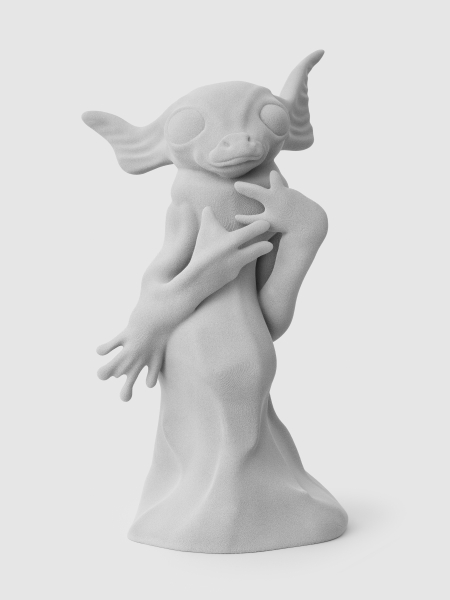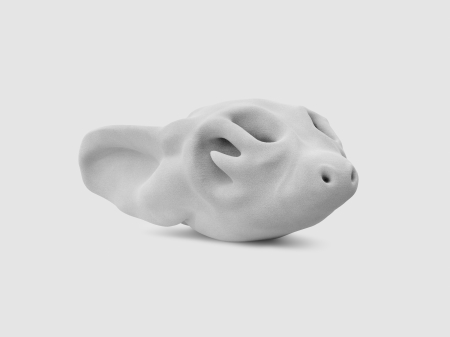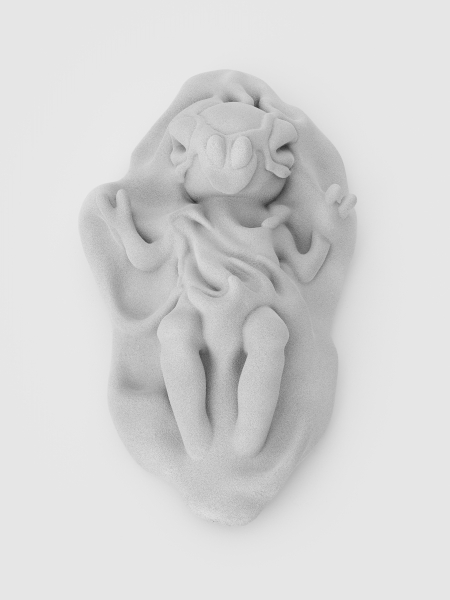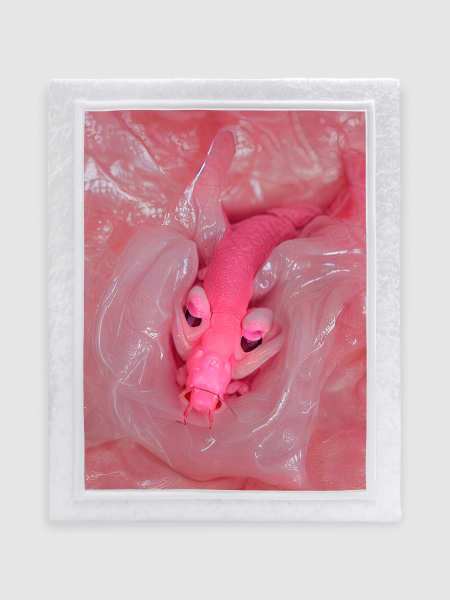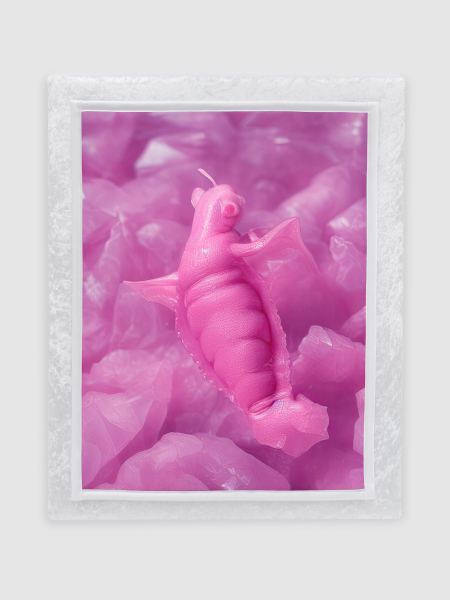Menu
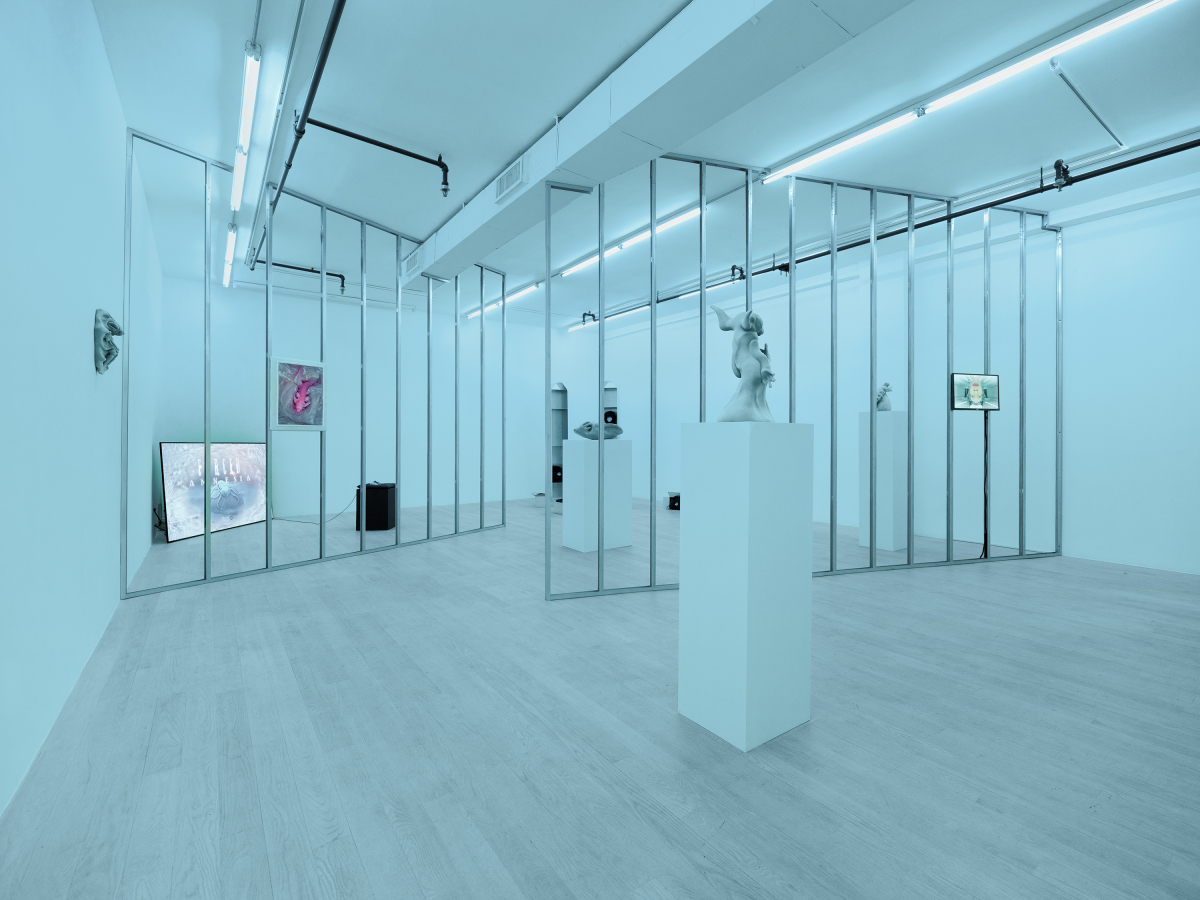
Installation view, exuviae with Stine Deja and Mary-Audrey Ramirez
Management is pleased to present exuviae, a duo exhibition by Danish artist Stine Deja and Luxembourgish artist Mary-Audrey Ramirez, with support from Kultur LX and the Danish Arts Foundation. A text by Adriana Blidaru accompanies the exhibition.
———
While exuviae doesn’t care much for linear time, it responds directly to the moment we’re in: one where human centrality is dissolving under ecological pressure and technological acceleration. As a viewer, you are thrown into a timeline where human history - on a species scale - has already fractured. Stepping into this world feels like studying the past from a far future, trying to piece together a cohesive narrative. Everything’s a little off, a little funny – but the kind of funny that leaves a pit in your stomach.
Artists Stine Deja and Mary-Audrey Ramirez, bring together two different species of speculation: Deja through suspended, digitized stasis; Ramirez through organic, erratic evolution. A dark thread of humor runs through both. Neither of them takes itself too seriously but both worlds seem to unfold in the long shadow of a humanity that no longer feels central, or even intact.
In what Claire Colebrook calls “twilight of the Anthropocene idols,” we face the crumbling of our species’ self-image - not as apex thinkers but as one adaptive system among others. Both artists work with this collapse, extending the legacy of post-internet aesthetics towards a kind of speculative anthropology, one that navigates the disorientation of non-centrality through hyper-rendered bodies and looping simulations.
Deja’s work imagines a future where humanity decided to hit pause on life. Not completely stopped, just suspended. In Tomorrow’s Heads, made with Danish author Ida Marie Hede, human heads are stored for future use, cryogenically frozen, waiting for their second act. They are like any other organs in a freezer except they hold on to their consciousness.
This dream is as old as human civilization: cheat death. But Deja draws attention to the logistics of this fantasy: what is the way to get there? Who does the freezing? Who is cleaning the tanks? Who is paying the power bill? The tone is clinical and eerie, evoking a theatrical absurdity found in an Ionesco play. Deja’s world highlights the sleek contrasts between human and technological evolution. These aesthetic choices reflect a nervousness about how much we want to control and preserve.
On the other hand, Ramirez’s world couldn’t care less about preservation or control. Her blobby, insectoid creatures - some recognizably cute, some totally unplaceable - aren’t waiting for any human timeline to fulfill their purpose. They’re constantly becoming. Their names – like Schminkie or Baby Jesus – suggest an anthropomorphic presence, but any sense of meaning dissolves just as quickly.
While they have strong cryptid energy, these creatures also echo real-world biological organisms: the indestructible Tardigrades, who can suspend their metabolism for years and survive exposure to space, yet otherwise live peacefully in mosses and lichens; or the Demodex mites—tiny worm-like beings buried in our pores and lashes, crawling out at night to mate, feast on sebum, and vanish before morning.
Ramirez’s creatures seem to be pulled from a dream, or from a footnote in a speculative biology journal. In this context, they appear as if they’ve been evolving alongside humanity the entire time, indifferent to its obsession with preserving and sustaining these cryogenic businesses. It’s implied that these creatures’ evolution remained unnoticeable, and perhaps took over completely when humans succumbed to their obsessive myth of self-preservation. Completely indifferent to us, they continued thriving in the margins, slowly taking over.
The works construct this exhibition like a mirror house built from broken glass, distorting a reflection just enough to feel familiar but awfully uncanny, a little grotesque, and strangely funny. Ramirez ripples where Deja freezes. If one holds time still, the other lets it slide sideways. Both seem to be asking the same core question: how do we relate to the unknown?
Forget monuments, archives, or passed-down stories. The future isn’t elsewhere - it’s already here, between these gallery walls, rendered in digital processes. Here, screens flicker, files are loading, and bodies do not breathe - they loop.
— Adriana Blidaru
———
Stine Deja (b. 1986 in Denmark). Lives and works in Copenhagen) received an MA from Royal College of Art. Solo exhibitions include Grave Matter at Ringsted Galleriet, Ringsted, Full Circle at Florit Florit, Palma; Heavy Render at OTP Copenhagen; Dawn Chorus, Vestjyllands Kunstpavillion, Videbæk, Denmark Cold Sleep at Tranen, Gentofte; Last Resort at kim? Contemporary Art Centre, Riga; Hard Core, Soft Bodies at Schimmel Projects, Dresden, and has executed several site-specific projects internationally. Deja’s work has been published in Cura, Nasty Magazine, Coeval Magazine, Kunstforum, Overstandard and many other publications. Her work is included in the collections of Arken, The New Carlsberg Foundation, The Danish Arts Foundation, Esbjerg Art Museum.
Mary-Audrey Ramirez (b. 1990 Luxembourg-City, Luxembourg. Lives and works in Berlin) studied under Thomas Zipp at the University of the Arts in Berlin Germany from 2010 to 2016. In 2019 she was the recipient of the prestigious Edward Steichen Award in Luxembourg for her textile-based sculptural and pictorial works. Her works have been shown in both solo and group exhibitions at institutions such as Casino Luxembourg - forum d’art contemporain, Luxembourg, Triennale für Kleinplastik, Fellbach, Max-Ernst-Museum, Brühl, Kunsthalle Gießen, Gießen, Kunstpalast, Düsseldorf, Dortmunder Kunstverein, Dortmund, TRAUMA, Berlin, Kai10, Arthena Foundation, Düsseldorf, Haus Mödrath, Kerpen Polansky Gallery, Prag und MARTINETZ, Cologne, Esch2022+ARS ELECTRONICA, Luxembourg/Linz. Her work is included in the collections of Kunstpalais Erlangen, Kunstmuseum Heidenheim, LBBW Bank, and the Kai10/Arthena Foundation. Her public commissions include the Grundschule, Fehrbelliner Tor, Berlin, and GEOMAR, Centre for Ocean Research, Kiel, Germany. Ramirez’s work has been published in Cura, Kunstforum, Monopol, Artforum, Sleek Magazine, Kaleidoscope Magazine, and her monograph have been published by Distanz.








